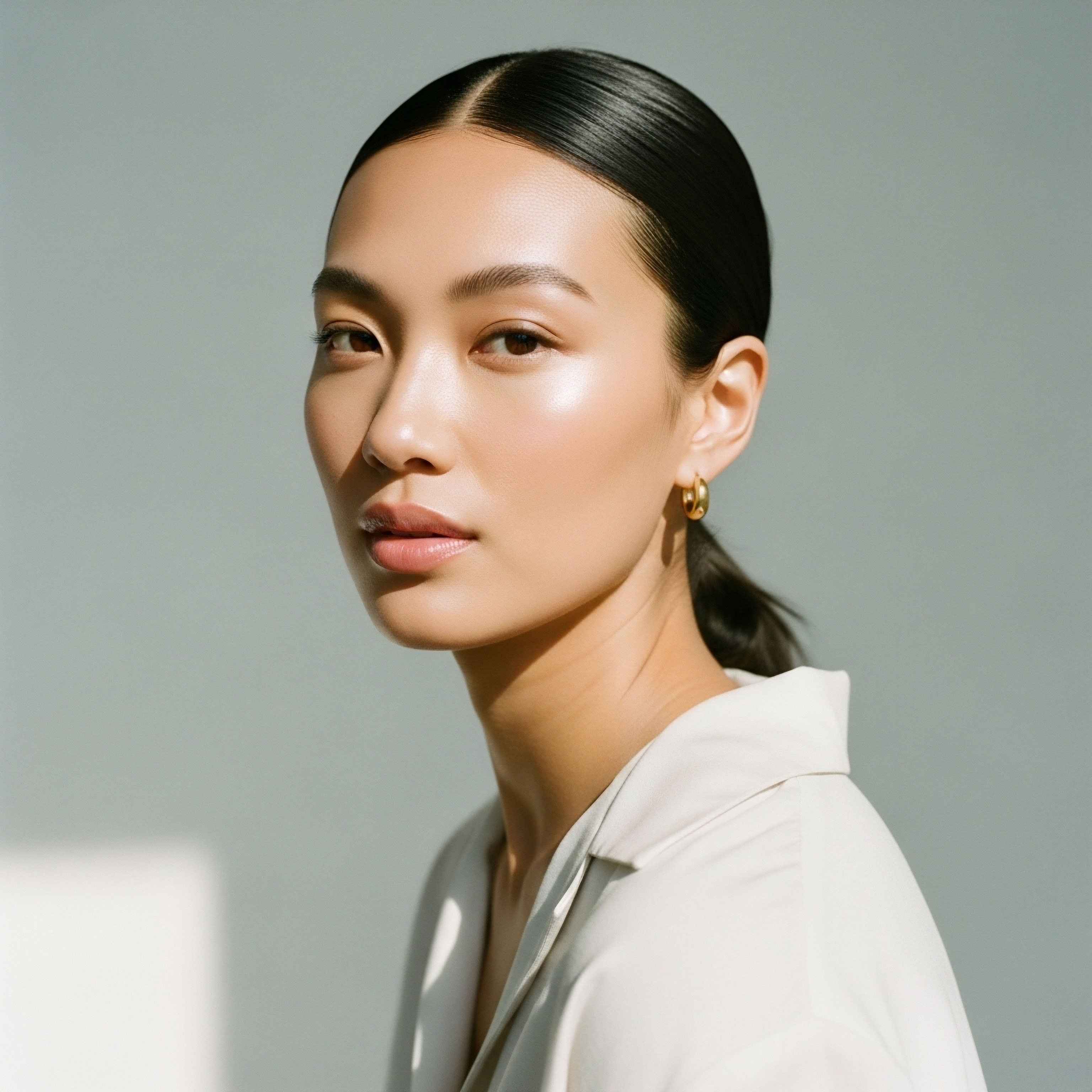

Fundamentals
The reflection in the mirror can often be the first messenger from our body’s intricate internal world. When you begin a journey of hormonal optimization, you might notice your skin communicating in a new language. This visible response is a direct conversation between your endocrine system and your body’s largest organ.
Understanding this dialogue is the first step in comprehending the profound connection between your internal biochemistry and your external vitality. The skin is a potent target for androgens, meaning its cells are rich with receptors ready to receive messages from hormones like testosterone. This sensitivity is what drives the changes you may observe, from shifts in texture and oiliness to the very structure and resilience of the skin itself.

The Skin as a Hormonal Organ
Your skin is an active participant in your endocrine system. It contains the cellular machinery to both respond to and metabolize hormones. When testosterone levels are optimized, this hormone circulates through the bloodstream and binds to androgen receptors in the skin’s layers. This binding initiates a cascade of cellular instructions.
In the sebaceous glands, which produce the skin’s natural oil (sebum), testosterone acts as a powerful stimulant. This can lead to an increase in oil production, which is a primary factor in the development of acne. Simultaneously, in the deeper layer of the skin, the dermis, testosterone communicates with cells called fibroblasts.
These cells are responsible for producing collagen and elastin, the proteins that give skin its firmness and elasticity. This dual action explains why the initial phase of testosterone therapy can feel like a contradiction, potentially bringing both the challenges of acne and the promise of improved skin structure.
Testosterone directly influences skin by regulating oil production and stimulating the cells responsible for collagen synthesis.
The experience of these changes is deeply personal. Your genetic predispositions, the specific hormonal protocol you are on, and your overall metabolic health all contribute to the unique way your skin responds. For men on Testosterone Replacement Therapy (TRT), this might manifest as a return of the oilier skin of their youth.
For women on low-dose testosterone protocols, the effects might be more subtle, perhaps a noticeable improvement in skin tone and resilience without a significant increase in oiliness. The key is to view these changes through a clinical lens, understanding them as predictable biological responses that can be managed and understood as part of a larger process of systemic recalibration.

Understanding Sebum and Skin Texture
Sebum is essential for maintaining a healthy skin barrier, protecting it from moisture loss and environmental damage. When testosterone levels rise, the sebaceous glands are signaled to produce more of this oil. For some, this results in a healthy “glow,” while for others, particularly in the initial months of therapy, this can lead to clogged pores and acne.
A study focusing on individuals undergoing testosterone therapy noted that the prevalence and severity of acne often peaked around six months into treatment, after which it tended to subside for the majority of users. This suggests an adaptative period, where the skin adjusts to the new hormonal baseline.
Beyond oil production, sustained testosterone levels contribute to the structural integrity of the skin. By signaling fibroblasts to produce more collagen, optimized testosterone can help maintain skin thickness and firmness, counteracting the natural thinning process that occurs with age. This structural support is a cornerstone of long-term skin health.


Intermediate
As your body acclimates to a new hormonal equilibrium, the skin’s initial, sometimes turbulent, response begins to evolve into a more stable, long-term state. This transition moves beyond the simple presence of testosterone to the more complex interplay of its metabolites and the specific sensitivity of your skin’s cellular receptors.
A clinically guided protocol anticipates this evolution, understanding that the effects observed at six months are different from those seen after several years. The goal of hormonal optimization is to achieve a physiological balance that supports systemic health, and the skin serves as a clear and visible indicator of this internal state. Examining the specific protocols for men and women reveals how dosage and therapeutic goals shape the long-term cutaneous outcomes.

Clinical Protocols and Cutaneous Timelines
The journey of the skin on testosterone therapy follows a predictable, though individually variable, timeline. For a man starting a standard TRT protocol, often involving weekly injections of Testosterone Cypionate, the first year is a period of significant adaptation. For women, who use much lower doses, the changes are typically more subtle and focused on restoring dermal integrity.

The Male TRT Experience a Timeline
The initial phase of TRT for men is characterized by the body responding to restored androgen levels. This creates a distinct sequence of cutaneous events.
- Months 1-6 The most dramatic increase in sebum production occurs during this period. This can trigger acne, particularly in individuals predisposed to the condition. This is a direct response of the sebaceous glands to renewed androgenic stimulation.
- Months 6-12 Acne severity often peaks and then begins to decline as the skin adapts. Concurrently, changes in hair patterns become more noticeable. Vellus hairs on the face and body may become thicker and darker terminal hairs.
- Year 1 and Beyond After the first year, acne tends to stabilize at a minimal level for most individuals. The focus shifts to two primary long-term effects ∞ sustained collagen production, which supports skin thickness and elasticity, and the potential for androgenetic alopecia, or male pattern baldness. This hair loss is driven by the conversion of testosterone to dihydrotestosterone (DHT) in susceptible hair follicles.
Over time, the skin’s response to testosterone shifts from acute changes like acne to long-term structural alterations in collagen and hair follicles.

Hormonal Influence on Skin Structures
The long-term appearance of the skin under testosterone optimization is governed by its influence on several key structures. Understanding these distinct effects helps to form a complete picture of the benefits and considerations of therapy.
The following table outlines the primary long-term effects of optimized testosterone levels on different components of the skin, based on clinical observations.
| Skin Component | Long-Term Effect of Testosterone Optimization | Underlying Biological Mechanism |
|---|---|---|
| Sebaceous Glands | Normalization of sebum production after an initial increase. | Initial upregulation of glands followed by systemic adaptation to stable hormone levels. |
| Dermal Fibroblasts | Increased collagen synthesis, leading to improved skin thickness and firmness. | Androgen receptors in fibroblasts are stimulated, promoting the production of structural proteins. |
| Hair Follicles (Body/Face) | Progressive increase in hair thickness and coverage. | Conversion of fine vellus hairs to thick terminal hairs in androgen-sensitive areas. |
| Hair Follicles (Scalp) | Potential for miniaturization, leading to androgenetic alopecia. | High sensitivity of genetically predisposed follicles to dihydrotestosterone (DHT). |

The Role of Estrogen and Aromatase Inhibitors
In many male TRT protocols, medications like Anastrozole are used to manage the conversion of testosterone to estrogen. This process, called aromatization, is a natural part of hormonal metabolism. While maintaining a healthy level of estrogen is vital for men’s health, including bone density and cardiovascular function, excessive levels can lead to unwanted effects.
From a dermatological perspective, balanced estrogen is also important for skin hydration and health. The use of an aromatase inhibitor like Anastrozole is a balancing act. Its purpose is to prevent supraphysiological estrogen levels while preserving enough for essential bodily functions. This careful management within a clinical protocol ensures that the dermatological benefits of testosterone are not compromised by an imbalance in the testosterone-to-estrogen ratio.


Academic
A sophisticated understanding of testosterone’s long-term impact on skin health requires moving beyond systemic hormone levels and into the microenvironment of the skin itself. The clinical outcomes we observe, such as acne, hair growth, and changes in skin quality, are the macroscopic results of complex intracellular events.
The skin is a site of active steroidogenesis, where testosterone is not just a visitor but a substrate, transformed by local enzymes into more potent metabolites. The individual variability in response to testosterone therapy is largely explained by the genetic expression of specific enzymes and the density and sensitivity of androgen receptors within the dermal and epidermal layers.
This cellular-level perspective provides the ultimate explanation for why the same dose of testosterone can produce vastly different results in two different people.

The Cellular Mechanics of Androgen Action in Skin
The biological activity of testosterone in skin tissue is primarily mediated through its conversion to dihydrotestosterone (DHT) by the enzyme 5-alpha reductase. There are two main isoenzymes of 5-alpha reductase, Type 1 and Type 2. Type 1 is found predominantly in the sebaceous glands, while Type 2 is concentrated in the hair follicles of the scalp and genital skin.
DHT binds to the androgen receptor with approximately three to ten times the affinity of testosterone, making it a much more potent activator of androgenic gene transcription. This localized conversion is a critical control point that dictates the intensity of the androgenic signal within a specific skin structure.

Receptor Sensitivity and Gene Transcription
Once DHT or testosterone binds to an androgen receptor inside a skin cell, the receptor-hormone complex translocates to the cell nucleus. There, it binds to specific DNA sequences known as androgen response elements (AREs). This binding event initiates the transcription of target genes.
The products of these genes are the proteins that carry out the final physiological effects. For example, in a sebaceous gland cell, this process leads to the production of enzymes involved in lipid synthesis, resulting in increased sebum. In a dermal fibroblast, it upregulates the genes for Type I and Type III collagen.
The concept of “receptor sensitivity” refers to the efficiency of this entire process. Genetic polymorphisms can affect the structure of the androgen receptor, the efficiency of 5-alpha reductase, and other co-factors, leading to a stronger or weaker response to the same amount of hormone.
The conversion of testosterone to DHT by 5-alpha reductase within the skin itself is the key amplifier of androgenic effects on glands and follicles.
This explains the observation from clinical studies that serum testosterone levels do not always correlate directly with the severity of dermatological outcomes like acne or alopecia. An individual may have testosterone levels within the optimal physiological range but possess highly efficient 5-alpha reductase enzymes and a high density of sensitive androgen receptors in their sebaceous glands, leading to persistent acne.
Another individual might have the same serum levels but experience minimal skin issues due to a different genetic makeup at the cellular level.

What Is the Molecular Basis for Skin Aging and Testosterone
The visible signs of aging in the skin, such as thinning, wrinkling, and dryness, are linked to a decline in hormonal signaling. Testosterone’s role in mitigating these changes is rooted in its ability to directly influence the skin’s structural matrix and hydration.
The following table details the molecular pathways through which testosterone optimization can counteract common age-related skin changes.
| Age-Related Skin Change | Testosterone-Mediated Molecular Counter-Action | Clinical Significance |
|---|---|---|
| Dermal Atrophy (Thinning) | Upregulation of COL1A1 and COL3A1 gene expression, leading to increased synthesis of Type I and Type III collagen. | Maintains skin thickness, structural integrity, and resilience. |
| Reduced Elasticity | Potential modulation of elastin fiber organization and fibroblast activity. | Contributes to improved skin firmness and tonicity. |
| Dryness and Barrier Dysfunction | Stimulation of sebum production and influence on epidermal lipid synthesis. | Enhances the skin’s natural moisturizing factors and strengthens the protective barrier. |
| Impaired Wound Healing | Androgens are known to modulate the inflammatory and proliferative phases of wound repair. | May contribute to more efficient tissue repair and regeneration. |

Androgenetic Alopecia a Case of Paradoxical Signaling
The phenomenon of androgenetic alopecia presents a fascinating paradox. While testosterone promotes hair growth on the face and body, its metabolite DHT triggers the progressive miniaturization of genetically susceptible scalp hair follicles. This occurs because the androgen receptor signaling in these specific follicles, when activated by DHT, initiates a gene transcription program that shortens the anagen (growth) phase of the hair cycle.
Over successive cycles, the follicle produces progressively finer, shorter, and less pigmented hairs, eventually leading to visible thinning. This process is a clear example of how the same hormonal signal can have opposite effects in different tissues, dictated entirely by the local genetic programming of the target cells.

References
- Wierckx, K. Van de Peer, F. Verhaeghe, E. Dedecker, D. Van Caenegem, E. Toye, K. & T’Sjoen, G. (2014). Short- and long-term clinical skin effects of testosterone treatment in trans men. Journal of Sexual Medicine, 11 (4), 1071 ∞ 1079.
- Lephart, E. D. (2018). Modulating the testosterone pathway ∞ a new strategy to tackle male skin aging?. Dermatology and Therapy, 8 (3), 359-367.
- Imhof, R. L. Davidge-Pitts, C. J. Miest, R. Y. N. Nippoldt, T. B. & Tollefson, M. M. (2020). Dermatologic disorders in transgender patients ∞ A retrospective cohort of 442 patients. Journal of the American Academy of Dermatology, 83 (5), 1516 ∞ 1518.
- Mayo Foundation for Medical Education and Research. (2022). Testosterone therapy ∞ Potential benefits and risks as you age. Mayo Clinic.
- Concierge MD. (2024). The Pros And Cons Of TRT For Anti-Aging Treatment.

Reflection
Having explored the intricate science connecting testosterone to the health and appearance of your skin, the journey now turns inward. The information presented here is a map, detailing the biological terrain of hormonal influence. Your personal experience, however, is the actual territory. How does this knowledge reframe your understanding of the changes you see?
Can you view the shifts in your skin not as isolated events, but as markers of a deeper systemic recalibration? This understanding is the foundation of true partnership with your body. The path forward involves observing these signals with clinical curiosity, recognizing that your skin is providing constant feedback on your internal hormonal environment. This awareness is the first and most critical step toward navigating your own unique path to sustained wellness and vitality.



